

The X-15 was launched on its first glide flight fifty years ago, on June 8, 1959. The X-15-1 56-6670 had been carried on four captive flights in March and April before it made a single glide flight
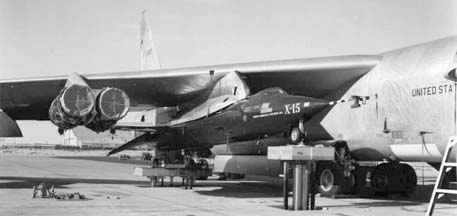 X-15-1 being hoisted under the wing of the NB-52A for a mating test on December 2, 1959. A pair of hydraulic jacks were installed in the flightline at the NASA Flight Research Center for the purpose of lifting the X-15 to the pylon. Note that the leading edge of the wing of the NB-52A still hasn't been painted black. The inboard engine nacelle has been stripped of its access panels. (NASA Photo E4314)
X-15-1 being hoisted under the wing of the NB-52A for a mating test on December 2, 1959. A pair of hydraulic jacks were installed in the flightline at the NASA Flight Research Center for the purpose of lifting the X-15 to the pylon. Note that the leading edge of the wing of the NB-52A still hasn't been painted black. The inboard engine nacelle has been stripped of its access panels. (NASA Photo E4314)
In 1958, North American Aviation modified 52-0003 to launch the X-15. A pylon was added to the right wing, inboard of the engines, to support the X-15 and supply it with fluids, gases, and power.
The surfaces of the X-15 pylon facing the B-52 fuselage were painted black to reduce glare.
A notch was cut in the trailing edge of the right wing to accommodate the tail of the X-15.
The black anti-glare panel was removed from the tail turret, leaving a small patch of black on either side of the tail gunner’s station.
The tail turret was removed, and the space was faired over.
The AFFTC badge and the “003” were removed from the forward fuselage.
The words “UNITED STATES AIR FORCE” on the forward fuselage were moved down to a position below the video camera housing.
The nose radome was replaced with a black radome. The chin and belly radomes were replaced with white radomes.
An additional zero was added to the tail number, so that it read 20003.
Housings for video and motion picture film cameras were added to the right side of the fuselage.
An additional window was installed at the launch panel operator’s station on the right side of the fuselage.
Three floodlights were flush-mounted in the right side of the fuselage. A forward facing floodlights was mounted in a housing directly below the aft video camera.
Ten vents were added to either side of the bomb bay. A liquid oxygen jettison pipe extended from the forward end of the bomb bay on the left side of the fuselage. Two liquid oxygen overflow vents were installed on the left side of the bomb bay.
A small, red square surrounded the base of the liquid oxygen vents and jettison pipe on the left side of the bomb bay.
The photo theodelite target was removed from the upper fuselage.
A black, striped photo-resolution target on a white background was painted on the right side of the fuselage below the trailing edge of the wing. A smaller black rectangle appeared directly below the white rectangle.
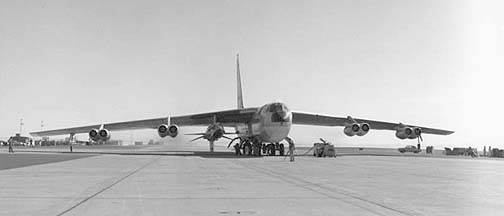 There was concern that the noise from the two J57 jet engines in the pod adjacent to the X-15 might cause damage to the structure of the X-15. Acoustic damage tests were performed by running the number 5 and 6 engines of the NB-52A with the X-15 mounted on its pylon. Note the exhaust smoke near the inboard starboard engine pylon. (Air Force Flight Test Center History Office AFFTC/HO)
There was concern that the noise from the two J57 jet engines in the pod adjacent to the X-15 might cause damage to the structure of the X-15. Acoustic damage tests were performed by running the number 5 and 6 engines of the NB-52A with the X-15 mounted on its pylon. Note the exhaust smoke near the inboard starboard engine pylon. (Air Force Flight Test Center History Office AFFTC/HO)
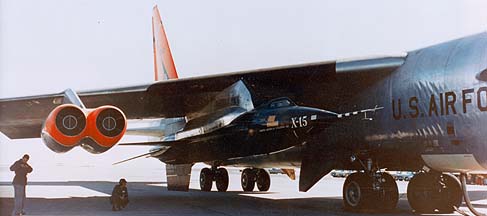 The X-15-1 hangs from the pylon during acoustic damage tests in early 1959. DayGlo orange has been applied to the tail and engines of the NB-52A. (AFFTC/HO)
The X-15-1 hangs from the pylon during acoustic damage tests in early 1959. DayGlo orange has been applied to the tail and engines of the NB-52A. (AFFTC/HO)
Following the structural testing of the X-15 mating devices in late 1958, large areas of the nose, tail, wingtips, and engine inlets of the NB-52A were painted Day-Glo orange . Day-Glo orange was used extensively on the aircraft operated from Edwards AFB in that era because it contrasted sharply with the dark blue desert sky and made tracking airplanes in flight easier. Also, orange wreckage is much easier to spot in the desert than aluminum, which tends to mirror the color of its surroundings.
The Day-Glo around the cockpit raked down along the sides of the fuselage, all the way around the bottom. The trailing edge of the orange area ran from the forward upper corner of the lower deck window to the outboard, rear corner of the aft window in each of the pilots’ escape hatches.
The windshield frames on either side of the center panel of the windshield were painted matte black.
Each wingtip was painted black on the top and white on the bottom. A broad area of Day-Glo was painted inboard of the wingtip stripes on both the top and bottom of the wings. The flaps of just the right wing were painted white.
The leading edge of the right wing was painted black for several feet on either side of the X-15 pylon. On the upper surface of the wing the inboard edge of the anti-glare panel was clipped perpendicular to leading edge of the wing. The outboard edge was clipped along a line perpendicular to the fuselage.
The Day-Glo on the engine inlets was scalloped to a point on either side of the nacelles. White cheat lines ran along the edge of the Day-Glo on the inlets.
Almost the entire vertical stabilizer was Day-Glo orange. The huge orange area of the B-52’s tail was a landmark that stood out distinctly from a great distance away. Spectators at the runway could see the tail of the B-52 approaching long before the rest of the bomber and its convoy of support vehicles came into view.
The 12-inch words “UNITED STATES AIR FORCE” on the forward fuselage were replaced with “U. S. AIR FORCE” in twenty-four inch tall letters.
A small black square was added directly above the NACA inlet near the belly radome.
Each side of the orange vertical stabilizer was adorned with a large black chevron. This was typical of the aircraft assigned to the AFFTC. The chevrons were not exact mirror images of one another. The AFFTC badge was applied within the black chevron on the tail.
The badge of the Air Research and Development Command (ARDC) was applied to the side of the fuselage, below the cockpit, where the AFFTC badge had been before.
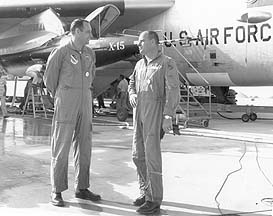 Charles Bock Jr. and Jack Allavie tested the modifications to the NB-52A and piloted it on the early X-15 missions. (AFFTC/HO)
Charles Bock Jr. and Jack Allavie tested the modifications to the NB-52A and piloted it on the early X-15 missions. (AFFTC/HO)
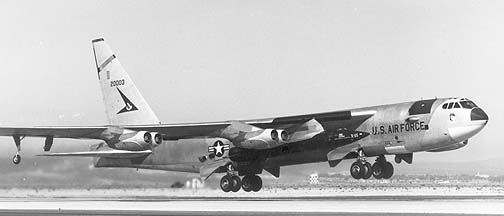 The NB-52A takes off with the X-15-1 on one of the first three captive carry flights in March and April, 1959. The first flight on March 10 was an intentional captive flight. Subsequent flights on April first and tenth were aborted attempts at a glide flight. On flight 1-A-3, the unexpected high intensity noise produced by the turbulence in the notch in the trailing edge of the NB-52A's wing cracked the skin of the upper rudder of the X-15. The dayglo orange paint adorning the nose of the NB-52A extends around the bottom of the fuselage. The badge of the Air Research and Development Command (ARDC) has been applied to the side of the fuselage, below the cockpit.(AFFTC/HO)
The NB-52A takes off with the X-15-1 on one of the first three captive carry flights in March and April, 1959. The first flight on March 10 was an intentional captive flight. Subsequent flights on April first and tenth were aborted attempts at a glide flight. On flight 1-A-3, the unexpected high intensity noise produced by the turbulence in the notch in the trailing edge of the NB-52A's wing cracked the skin of the upper rudder of the X-15. The dayglo orange paint adorning the nose of the NB-52A extends around the bottom of the fuselage. The badge of the Air Research and Development Command (ARDC) has been applied to the side of the fuselage, below the cockpit.(AFFTC/HO)
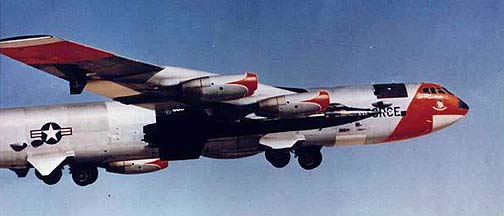 Only the flaps on this side of the NB-52A are painted white. (AFFTC/HO)
Only the flaps on this side of the NB-52A are painted white. (AFFTC/HO)
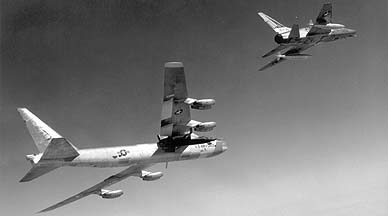 A North American F-100D flies chase for the NB-52A on a captive carry flight of the X-15-1. (AFFTC/HO)
A North American F-100D flies chase for the NB-52A on a captive carry flight of the X-15-1. (AFFTC/HO)
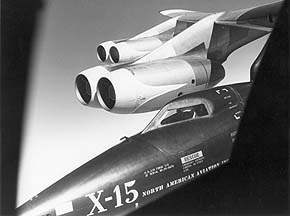 The original window at the launch panel operator's station provided a limited view of the X-15 on the pylon. (AFFTC/HO)
The original window at the launch panel operator's station provided a limited view of the X-15 on the pylon. (AFFTC/HO)
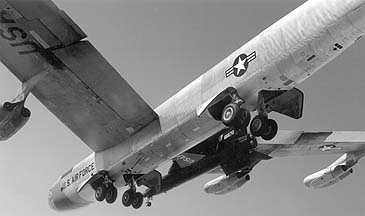 The function of the landing gear of the X-15 was tested during the captive carry missions. (AFFTC/HO)
The function of the landing gear of the X-15 was tested during the captive carry missions. (AFFTC/HO)
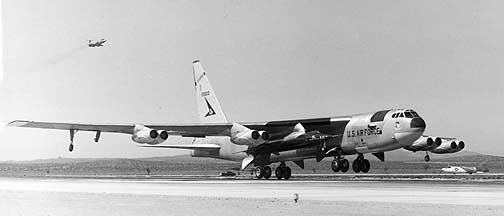 The NB-52A makes a high speed no-flaps landing on Runway 04 with the X-15-1 under its wing following one of the first three captive flights. The landing gear of the X-15 has been extended in an in-flight test. The no-flaps landing resulted in a nose high landing attitude. The nose of the Stratofortress fell rapidly once the rear landing gear contacted the runway. Note the Lockheed F-104 Starfighter chase plane flying overhead and the Vought F8U Crusader on the taxiway in the background. A Republic F-105 Thunderchief is just visible behind the landing gear of the NB-52A. (AFFTC/HO)
The NB-52A makes a high speed no-flaps landing on Runway 04 with the X-15-1 under its wing following one of the first three captive flights. The landing gear of the X-15 has been extended in an in-flight test. The no-flaps landing resulted in a nose high landing attitude. The nose of the Stratofortress fell rapidly once the rear landing gear contacted the runway. Note the Lockheed F-104 Starfighter chase plane flying overhead and the Vought F8U Crusader on the taxiway in the background. A Republic F-105 Thunderchief is just visible behind the landing gear of the NB-52A. (AFFTC/HO)
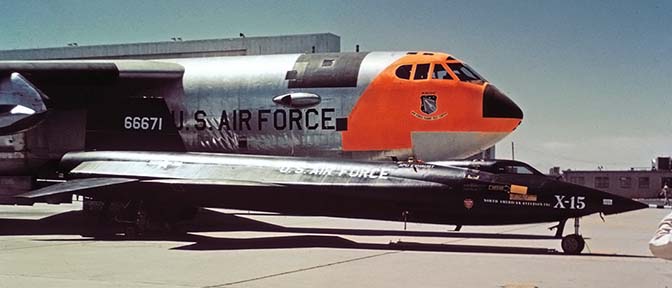 The North American X-15 made its first public appearance at the Edwards Air Force Base Open House and Airshow Display, held on May 19, 1959. It was posed with the NB-52A, 52-0003. The X-15-2 was delivered with only one VHF antenna on the lower fuselage. Later in the program a second VHF antenna was added. Go to more photos of the 1959 Edwards AFB Airshow. (Richard Lockett)
The North American X-15 made its first public appearance at the Edwards Air Force Base Open House and Airshow Display, held on May 19, 1959. It was posed with the NB-52A, 52-0003. The X-15-2 was delivered with only one VHF antenna on the lower fuselage. Later in the program a second VHF antenna was added. Go to more photos of the 1959 Edwards AFB Airshow. (Richard Lockett)
Following the third captive flight on April 10, 1959 and before the May 19 Open House Display, the Day-Glo orange under the fuselage of the NB-52A was removed. The lower edge of the paint was a horizontal line about a foot and a half below the top of the chin radome. It ran back to a vertical edge that ran up to the center of the bottom of the lower deck window.
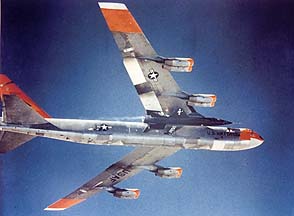 The NB-52A carries the X-15-1 on either mission 1-A-4 on May 21, 1959 or 1-1-5 on June 8. (Museum of the USAF via Greg Spahr)
The NB-52A carries the X-15-1 on either mission 1-A-4 on May 21, 1959 or 1-1-5 on June 8. (Museum of the USAF via Greg Spahr)
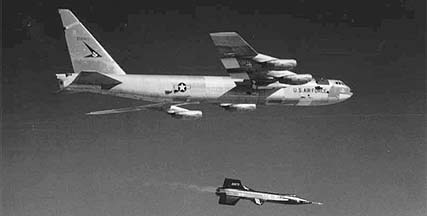 The X-15-1 with Scott Crossfield at the controls was launched from the NB-52A on its first flight on June 8, 1959. Charles Bock and Major Jack Allavie were piloting the NB-52A. This was the only intentional glide flight of the X-15 program. (AFFTC/HO)
The X-15-1 with Scott Crossfield at the controls was launched from the NB-52A on its first flight on June 8, 1959. Charles Bock and Major Jack Allavie were piloting the NB-52A. This was the only intentional glide flight of the X-15 program. (AFFTC/HO)
Link to NASA Dryden X-15 Photo Gallery Contact Sheet.
The great source of information about the X-15 program is X-15 Research Results, which is available online.
It has been asserted that the Boeing NB-52B Stratofortress, carrying Air Force serial 52-0008, can lay claim to being the airplane that has seen and participated in more history than any other single airplane. For forty-five years, the NB-52B was a fixture at Edwards Air Force Base. While the NB-52B is most famous for launching the three North American X-15 rocket planes, it continued to serve in the role of launch platform for a multitude of programs until its final mission on November 16, 2004. It was the oldest flying B-52 by nearly ten years.The NB-52B launched the three X-15 hypersonic rocket planes.
It launched the Northrop HL-10, Northrop M2-F2/F3, Martin Marietta X-24A and Martin Marietta X-24B lifting bodies.
It simulated the steep, power off approach to landing used by the Space Shuttles.
It assisted in the collection of data about wake turbulence from large aircraft.
It served as an air-to-air gunnery target.
It launched 3/8-scale F-15 Remotely Piloted Research Vehicles (RPRV) and Spin Research Vehicles (SRV).
It launched a Ryan Firebee II drone and the Ryan Firebee based Drones for Aeroelastic Structures Testing (DAST).
It launched the Highly Maneuverable Aircraft Technology (HiMAT) RPRVs.
It dropped the 48,000-pound Space Shuttle Reusable Booster Drop Test Vehicle (SRB/DTV).
It released a simulated F-111 crew module from its bomb bay to evaluate new parachute recovery systems.
It was the first airplane to launch a satellite into orbit on the Orbital Sciences Pegasus booster.
It tested the drag chute used to decelerate space shuttle orbiters.
It tested pollution reducing fuel additives with a pair of jet engines mounted under its bomb bay.
It launched the X-38 Space Station Crew Return Vehicles.
It launched the X-43A Hyper-X Supersonic Combustion Ramjets.
The book is 200 pages long. It contains 246 color photographs, 89 black and white photographs, and 2 other illustrations.
You can preview the first several pages of the book.
Books are printed on demand by Lulu.com. When you order one, it is placed in your Lulu.com shopping cart. Lulu.com prints, packages, and ships the book direct to you.

Put a copy of the softcover edition of Balls Eight: History of the Boeing NB-52B Stratofortress Mothership in your Lulu.com shopping cart for $74.95.

Put a copy of the hardcover edition of Balls Eight: History of the Boeing NB-52B Stratofortress Mothership in your Lulu.com shopping cart for $79.95.
Revell has re-released Monogram's 1/72-scale Boeing NB-52B Stratofortress with X-15A-2 kit. You need this book to help you establish the appropriate paint scheme for any particular NB-52B mission that you want to model.
The book is 96 pages long.
You can preview the first several pages of the book.
Books are printed on demand by Lulu.com. When you order one, it is placed in your Lulu.com shopping cart. Lulu.com prints, packages, and ships the book direct to you.
 Put a copy of the softcover edition of Painting Guide for the Boeing Stratofortress Motherships in your Lulu.com shopping cart for $44.95.
Put a copy of the softcover edition of Painting Guide for the Boeing Stratofortress Motherships in your Lulu.com shopping cart for $44.95.
You can buy a 2020 calendar featuring photographs of the Boeing NB-52B Stratofortress Mothership that launched the X-15s in the 1960s and continued launching research vehicles until 2004.
It has been asserted that the Boeing NB-52B Stratofortress, carrying Air Force serial 52-0008, can lay claim to being the airplane that has seen and participated in more history than any other single airplane. This calendar features a dozen pictures of the NB-52B carrying some of the research vehicles that it launched over the years. Photo sources: Air Force, NASA, Richard Lockett, Brian Lockett:
North American X-15-1, 1960
North American X-15-3, 1963
North American X-15A-2, 1967
Northrop HL-10, 1969
Martin-Mariettta X-24A, 1970
Northrop M2-F3, 1972
Martin-Mariettta X-24B, 1973
Orbital Sciences Pegasus, 1989
Supersonic Supercruise, 1995
X-38 V-131R, 2000
X-43A Hyper-X, 2004
 Put a copy of the Balls Eight: Boeing NB-52B Stratofortress Mothership: 2020 calendar in your Lulu.com shopping cart for $14.95.
Put a copy of the Balls Eight: Boeing NB-52B Stratofortress Mothership: 2020 calendar in your Lulu.com shopping cart for $14.95.
*The first position of the mission number identifies which X-15 was involved, the second number indicates how many times that X-15 had been launched, and the third number indicates how many times it had been carried by an NB-52.
Send a message to Brian